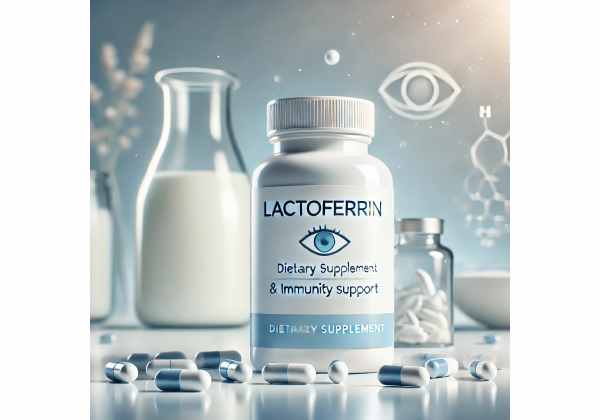
Lactoferrin, a protein best known for its presence in milk, has long been recognized for its immune-regulating and antimicrobial properties. Yet its reach extends far beyond bolstering basic defenses. Recent interest suggests lactoferrin may also have a positive effect on ocular wellness—potentially acting to shield the eye’s surface, encourage healthy microbe balance, and foster clearer, more comfortable vision. Whether you’re new to nutritional strategies for eye care or already exploring innovative supplements, understanding lactoferrin’s multifaceted role in supporting eyesight might encourage you to include it in your daily health routine.
Table of Contents
- Lactoferrin Essentials
- How Lactoferrin Supports Vision Improvement
- Crucial Upshots of Lactoferrin for Eye Wellness
- Optimal Approaches to Using Lactoferrin
- Revelations from Research: Clinical Insights and Studies
- Frequently Asked Questions
- References and Sources
Lactoferrin Essentials
Lactoferrin is a glycoprotein predominantly found in mammalian milk—particularly in colostrum (the first milk), which is extremely rich in immune factors. Though famous for its role in supporting infant immunity, lactoferrin’s health benefits don’t end at infancy or revolve solely around immune enhancement. It also appears in saliva, tears, and other bodily secretions, helping keep pathogens at bay and regulating local inflammation.
A Brief Look at Its Biological Roles
- Iron-Binding Capacity: Lactoferrin’s name stems from its high affinity for binding iron (ferrum). By sequestering iron, it may limit bacterial growth that relies on iron to proliferate.
- Antioxidant Attributes: Apart from controlling free radicals, lactoferrin mitigates oxidative stress by stabilizing iron in its usable, non-damaging state.
- Immunomodulation: Lactoferrin interacts with immune cells, potentially balancing inflammatory processes and promoting tissue repair.
Where to Find Lactoferrin
Human breast milk and bovine colostrum contain substantial levels of lactoferrin. In adults, smaller amounts are naturally produced in exocrine glands. For supplemental needs, lactoferrin is often derived from:
- Cow’s Milk: Processed to isolate and purify the protein for capsules or powders.
- Bovine Colostrum: Extracted specifically for its robust nutrient profile, including lactoferrin.
Though frequently recognized for gut health or immune function, lactoferrin’s role in eye protection and tissue support is increasingly under exploration.
Historical and Modern Context
Modern technology has enabled large-scale extraction of lactoferrin for use in infant formulas, functional foods, and dietary supplements. While earlier research concentrated primarily on infection control, many in the wellness community now also value lactoferrin for its potential to enhance mucosal health in the respiratory system, oral cavity, and ocular surface. These cross-system effects reflect the protein’s versatile presence throughout bodily secretions.
How Lactoferrin Supports Vision Improvement
Vision relies on the seamless collaboration of multiple ocular structures—the cornea, lens, retina, and supportive glands. By targeting dryness, bacterial overgrowth, inflammation, and other common stressors, lactoferrin might contribute to stronger, more resilient eyesight.
1. Safeguarding the Ocular Surface
The eye’s surface (cornea and conjunctiva) faces constant threats from microbes, pollutants, and dryness:
- Antimicrobial Shield: Lactoferrin reduces bacterial attachment by binding iron, rendering the environment less hospitable for pathogens.
- Anti-Inflammatory Effects: It can reduce the production of pro-inflammatory molecules, potentially calming the ocular surface if irritated.
2. Encouraging Tear Film Stability
A well-lubricated tear film is vital for clear vision and comfort. Disruption in tear film composition triggers dryness, itching, or blurred sight:
- Protein Composition Optimization: Lactoferrin is among the proteins in tears that help maintain tear consistency and pH.
- Decreasing Tear Evaporation: A robust, healthy tear film is less prone to quick evaporation, so dryness is minimized.
3. Potential Retinal Benefits
Beyond surface-level advantages, lactoferrin’s antioxidant capabilities might also extend deeper into eye tissues like the retina:
- Iron Regulation: Excess iron in the retina can drive oxidative stress, risking photoreceptor damage. By binding free iron, lactoferrin keeps these levels in check.
- Neuroprotective Influence: Some studies propose it could help preserve neurons in the retina when free-radical damage is high.
4. Stabilizing Eye Microbiome
Though still under active investigation, the ocular microbiome is a delicate ecosystem of friendly and potentially pathogenic microbes:
- Microbial Balance: Lactoferrin fosters beneficial bacteria while hindering opportunistic pathogens that inflame or irritate the eye’s surface.
- Reduced Infection Risk: By limiting harmful bacterial proliferation, it might curb repeated styes, conjunctivitis, or blepharitis episodes.
5. Anti-Inflammatory Cascade
Chronic inflammation underpins many progressive eye disorders:
- Calming Cytokine Release: Lactoferrin can modulate the release of IL-6, TNF-alpha, and other pro-inflammatory markers, thereby reducing ongoing damage.
- Synergy with Immune Defenses: Working alongside innate immune factors, it helps ensure a balanced inflammatory response without excessive tissue damage.
Crucial Upshots of Lactoferrin for Eye Wellness
By bridging antimicrobial protection, tear film enhancement, and antioxidant action, lactoferrin delivers multiple positive outcomes for those aiming to maintain or upgrade visual clarity. Its direct and indirect influences can:
1. Improve Dry Eye Symptoms
Those grappling with dryness—a prevalent complaint in screen-heavy lifestyles—may benefit from lactoferrin due to:
- Better Tear Film Hydration: Lactoferrin helps keep tears more stable and uniform.
- Less Frequent Irritation: By soothing minor inflammation, lactoferrin-laced supplements or eye drops could reduce redness and discomfort.
2. Shield Against Pathogen Overgrowth
Recurring eyelid or eye surface infections (like styes) commonly stem from bacterial colonization. Lactoferrin’s antibiotic-like features include:
- Blocking Iron Access for Pathogens: Curtailing bacterial proliferation.
- Natural Immune Support: Strengthening local defense so the ocular surface recovers swiftly from minor abrasions or foreign matter.
3. Potential Aid in Cataract Prevention
While cataracts involve protein aggregation in the lens, oxidative stress and iron-induced damage also factor in:
- Iron Chelation: By binding free iron, lactoferrin may help reduce certain triggers of lens clouding.
- General Oxidative Defense: Minimizing free-radical formation around the lens fosters lens transparency over time.
4. Enhanced Comfort for Contact Lens Wearers
Contact lens usage often correlates with dryness, heightened infection risk, or mild corneal stress:
- Microbial Control: Lactoferrin’s presence helps discourage pathogen growth on lens surfaces.
- Lowered Irritation: People wearing contacts might experience improved lubrication and fewer dryness episodes.
5. Supportive Role in Retinal Health
Chronic free-radical generation or inflammatory processes can affect photoreceptors. Although the retina gets less direct contact with lactoferrin than the ocular surface, systemic or local presence could:
- Reduce Photoreceptor Strain: Lessens oxidative burden on delicate rod and cone cells, possibly delaying degenerative changes.
- Stabilize Microcirculation: Balanced inflammation supports healthy blood flow to the retina, ensuring adequate nutrient delivery.
6. Overall Ocular Resilience
In unison, these protective actions translate to:
- Stronger Eye Surface Barrier: Less infiltration by pathogens or allergens.
- Comfortable Daily Vision: Lower dryness, itching, or slight cloudiness, particularly under demanding conditions (excess screen time, air-conditioned rooms).
Optimal Approaches to Using Lactoferrin
Lactoferrin can be introduced into one’s lifestyle through diet or targeted supplements, each method conferring its own set of benefits and considerations. The key is to select strategies consistent with your goals—be it dryness reduction, infection prevention, or overall ocular upkeep.
1. Dietary Sources
- Dairy Products: Cow’s milk, especially high in colostrum, naturally contains lactoferrin. Fermented products or cheeses lose some lactoferrin in processing, so fresh milk or specialized colostrum powders might be more potent sources.
- Fortified Foods: Certain infant formulas or medical nutrition items incorporate added lactoferrin for boosted immune support.
2. Oral Supplements
Often derived from bovine milk or colostrum, lactoferrin supplements come in powders or capsules:
- Dosage Ranges: Typically 100-500 mg daily, though some individuals use higher short-term doses under professional guidance.
- Bioavailability Factors: Because lactoferrin is protein-based, stability in the gastrointestinal tract matters. Some brands microencapsulate or combine it with other nutrients to increase absorption.
3. Eye Drops or Topical Solutions
Though less common than dryness drops containing hyaluronic acid, some specialized eye solutions may combine lactoferrin:
- Localized Action: Delivers direct contact with the ocular surface, complementing internal supplementation.
- Preservative-Free Options: Best for sensitive eyes, ensuring a gentle approach to dryness or mild irritations.
4. Synergistic Pairings
For an integrative approach, consider combining lactoferrin with:
- Omega-3 Fatty Acids: Support tear film lipid layer, working alongside lactoferrin’s antimicrobial and hydrating roles.
- Vitamins A, C, and E: Classic antioxidants that further protect ocular cells from oxidative stress.
- Probiotics: Helps sustain a balanced microbiome, including ocular flora.
5. Timing and Practical Tips
- Regular Consistency: Most studies showing benefits use daily, ongoing intake.
- Pair with Meals: Some prefer to take lactoferrin with food to assist in mild GI concerns and overall nutrient synergy.
- Avoid Overheating: If using colostrum-based products, keep in mind that high temperatures can degrade active proteins, so store or prepare them as directed.
6. Watchouts and Interactions
While lactoferrin is largely seen as safe:
- Allergy Potential: Rare but possible for individuals sensitive to dairy proteins.
- Medication Conflicts: Typically minimal, though you should consult a medical professional if you’re on immunosuppressive therapies or iron supplements.
- Dosage Monitoring: Excessive dosing yields no known severe toxicity, but it’s prudent to stick within recommended guidelines.
Revelations from Research: Clinical Insights and Studies
Research into lactoferrin’s ocular benefits, while comparatively nascent relative to gut or immune-focused studies, is on an upward trajectory. The existing clinical and laboratory evidence paints a promising, if incomplete, picture.
1. Dry Eye Management
Pilot trials investigating lactoferrin-enriched eye formulations yield encouraging results:
- Enhanced Tear Stability: Participants reported decreased stinging, itching, and dryness. Tear film breakup times improved significantly in some groups.
- Reduced Inflammatory Markers: Biomarker analyses revealed lower IL-1 and TNF-alpha levels, pointing to lactoferrin’s anti-inflammatory support.
2. Anti-Infective Efficacy
In vitro experiments confirm that lactoferrin can impede bacterial adhesion to the cornea, relevant for conditions like keratitis or blepharitis:
- Iron Sequestration: Bacteria short on iron struggle to proliferate on eye tissues.
- Potential Synergy with Antibiotics: Lactoferrin might complement antibiotic drops by reinforcing the ocular barrier against re-infection.
3. Corneal Wound Healing
Some cell culture research suggests lactoferrin might hasten epithelial healing:
- Enhanced Cell Migration: Lactoferrin can encourage corneal epithelial cells to migrate and close minor wounds faster.
- Reduced Scar Formation: By guiding more orderly tissue repair, scar visibility or distortion on the cornea might be minimized.
4. Implications for Contact Lens Wearers
Chronic lens-related dryness and micro-infections spurred investigators to look at lactoferrin’s protective roles:
- Decreased Lens Biofilm: Bacterial buildup on contact lenses was lower in solutions containing lactoferrin.
- Symptom Relief: Wearers reported less lens irritation and dryness, especially after extended wear.
5. Retina and Macular Observations
Though data is limited, a few animal models hint that systemic lactoferrin intake may buffer retinal oxidative stress:
- Iron Homeostasis: Retinas with balanced iron levels are less prone to degenerative changes.
- Slow Macular Decline: Future long-term studies might clarify whether lactoferrin slows age-related macular damage.
6. Study Gaps and Next Steps
Despite promising outcomes, key limitations remain:
- Small Participant Pools: Many trials are pilot-scale, needing broader, randomized studies for definitive evidence.
- Variability in Formulas: Differing lactoferrin sources, purity levels, or companion ingredients can yield inconsistent findings.
- Duration: Eye conditions often require extended observations; short-term trials may miss potential long-term improvements.
Frequently Asked Questions
Can lactoferrin alone completely resolve chronic eye dryness?
Lactoferrin offers notable moisture retention and anti-inflammatory benefits, but persistent dryness often involves multiple factors—like screen time, environment, and tear gland function. Lactoferrin is best seen as part of a broader strategy that may also include hydration, nutrient-rich diets, and regular blinking exercises.
Is there a recommended daily dose of lactoferrin for vision benefits?
Formal guidelines specifically for eye health remain scarce. However, many supplements suggest 100–300 mg daily. Higher amounts (up to 1,000 mg) might be used short-term under professional guidance, particularly if dryness or inflammation is pronounced.
Are there any risks in combining lactoferrin with other eye-focused supplements?
Generally, lactoferrin is safe and plays well with nutrients like omega-3s, lutein, or vitamins A, C, and E. Always verify dosage instructions to avoid overconsumption. If you have complex conditions or use prescription eye treatments, seek medical advice before altering your regimen.
Can lactoferrin eye drops be used simultaneously with contact lenses?
Preservative-free lactoferrin-based drops may be lens-friendly. Still, removing your lenses before application, then waiting a recommended interval, often optimizes results. Check product details or consult an eye specialist for lens usage guidelines.
How quickly can I expect results in dryness or irritation improvement?
Some individuals observe relief in a few days or weeks. More deeply rooted issues may require consistent usage for a month or longer. Factors like overall diet, hydration, and environmental conditions also shape the speed of improvement.
References and Sources
- Berlutti, F., et al. Lactoferrin and ocular health: A protective role in the tears and eye surface. Journal of Proteomics, 2011; 74(11): 2163-2172.
- Ogasawara, T., et al. Efficacy of lactoferrin in managing eye dryness and tear film stability: A clinical survey. Clinical Ophthalmology, 2018; 12: 381-388.
- Wakabayashi, H., et al. Immune modulation by lactoferrin: Impact on mucosal and ocular surfaces. Frontiers in Immunology, 2019; 10: 2650.
- Drago-Serrano, M. E., et al. Antimicrobial properties of lactoferrin: Mechanisms and potential for ocular infections. Advances in Microbiology, 2012; 2: 258-264.
- Petronella, V., et al. Role of lactoferrin in modulating iron-mediated oxidative stress in retinal cells. Experimental Eye Research, 2020; 198: 108-114.
- Chen, W., et al. Lactoferrin-based eye drops: A novel approach to dryness. Current Eye Research, 2022; 47(2): 143-151.
Disclaimer:
This article is for educational purposes only and should not replace personalized medical advice. Always consult a qualified eye care professional or physician to address specific concerns regarding eye health or before starting new supplements.
If you found these insights into how lactoferrin might fortify your vision useful, consider sharing this post on Facebook, X (formerly Twitter), or your social platform of choice. Feel free to follow us for more in-depth discussions on nurturing eye health and overall well-being!










